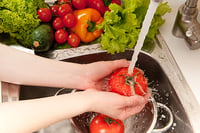 Picnics, backyard barbecues, and beach cookouts are some of the great summer joys. While enjoying the great outdoors, it is easy to forget that with higher ambient temperatures come increased risk of contaminated food. Bacteria thrive in warmer conditions and summer months require extra consideration with food safety. We have put together 10 safety tips to focus on for the most significant risk factors.
Picnics, backyard barbecues, and beach cookouts are some of the great summer joys. While enjoying the great outdoors, it is easy to forget that with higher ambient temperatures come increased risk of contaminated food. Bacteria thrive in warmer conditions and summer months require extra consideration with food safety. We have put together 10 safety tips to focus on for the most significant risk factors.
Cookouts
Separate - It is important to avoid cross-contamination with different types of meat and vegetables. Make sure to use separate cutting boards, platters, serving dishes, and tongs or wash between each use.Sauces and Marinades - Do not reuse marinades for basting and when basting, it is best to wait until the outside of the meat is well cooked to prevent contamination. Be sure to marinate in the refrigerator.
Thawing - Proper thawing helps the meat to cook more evenly and thoroughly preventing any undercooked spots to serve as a breeding ground for bacteria. Always thaw in a refrigerator and not on your kitchen counter.
Cooking - Make sure to cook to the recommended safe temperatures for the specific type of meat. USDA has a handy chart you can print for easy reference.
Serving - It is best to cut into the meat before serving and ensure it is properly cooked. When it comes time to plate for serving, use a new serving dish or wash the one used for raw food prep.
Holding - If you are not immediately serving the cooked food, it is best to maintain the food at 140 degrees and once served, it is best not to let it sit for more than 2 hours at room temperature.
Condiments - This is often an overlooked hazard, but it is best to bring out the ketchup, mustard, bbq sauce, etc. when the food is ready to be served.
On the Road
Grocery store - when running errands, make sure the grocery store is your last stop before you head home. This minimizes the time to the fridge/freezer.
Cooler - Utilizing a cooler to transport food can be great, but make sure to use plenty of ice/ice packs to keep the temperature below 40 degrees.
Packing - Separate the food into individual containers; this helps to prevent cross-contamination issues and makes it easier for seconds.
We also recommend checking out the USDA website for safe grilling rules to follow. Don't forget the golden rule of food safety, "when in doubt, throw it out!"
We have provided a safe cooking temperature chart that you can download and print out as a reference guide when cooking.









